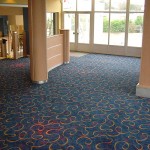Dealing With Water Damage in Older Houses

Older houses are often magnets for various types of damage, and homeowners must keep on top of their maintenance to ensure the avoidance of major disasters. There are several different ways to “run interference” for these types of problems, catching them before they begin and taking measures to ensure that they don’t happen in the future. One of the most common problems in older houses, and even in some of the newer ones, is water damage.
This type of damage can be extensive if it gets out of hand, and can often run amok before you even catch the problem. Water damage, unlike other types of problems, can occur deep within the foundation of your home as well as in hard-to-reach areas that will eventually begin colonies of mold and large areas of rot.
The Washer
The washer is connected to both cold and hot water lines. Check them frequently (at least once a month) to make sure that things are running smoothly. Make sure that your washer can be pulled out from the wall so that you can easily inspect the hoses and the ends of the water lines. Start with the joints and fix a leak if you find it. Sometimes, leaks can be repaired with duct tape or special types of glue, but in some cases they must be handled by a professional. Be sure to check both ends of the water lines. Clean or replace the filters once every three months to make sure they are doing their job. A blocked filter will slow the water flow into the washing machine, and may cause some malfunctions while increasing your water bill exponentially This problem is worse in areas with “hard water”. Inspect the shut off valve by looking for drips into the washing machine while it is not in use. If you detect a leak, replace the valve.
Hoses & Filters
Like in most appliances, problems often start in the hose. Keep at least 4 inches between the water connection and the back of the washer. This space will prevent the hose from kinking and bursting. Check the hoses and replace them if old. Consider installing steel-braided hoses to reduce the frequency of changing the hoses and ensure maximum usage. Regular hoses should be replaced every six months to a year, even if you don’t observe much wear and tear.
The Dryer
The dryer is connected to a ventilation hose, which should be changed ever couple of years. Check it carefully as often as you feel necessary to make sure there aren’t any holes or tears. The dryer ventilation hose must be connected to the outdoors, which leaves possibilities open for insects and small animals to chew at the hose, which can cause problems. Search for lint behind and under the dryer and make sure the vent pipe is not clogged. Make the exhaust as short as possible for the dryer to vent efficiently. Make sure that you change the lint trap often so that the dryer doesn’t have the opportunity to overheat, and therefore put stress on the hoses.
Utility Sink
The utility sink is sometimes the source for water related problems. Search for leaks under the sink and behind it; puddles of water or discoloration can be indications of a leak, and sunken boards can indicate that there has been a leak in the past. A drip in the trap under the sink can be a sign for problems and should be repaired immediately. Slow draining pipes may indicate a partially blocked drain, which should be handled by a professional. Household cleaners like Drain-O can sometimes dissipate a clogged drain, but if those don’t work, you probably won’t be able to fix it yourself. A constantly dripping faucet must me repaired promptly, and you should replace sink seals if they are cracked or loose. Damped or stained walls around plumbing pipes indicate an internal leak that must be fixed before additional damage occurs.



